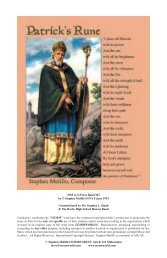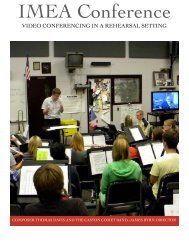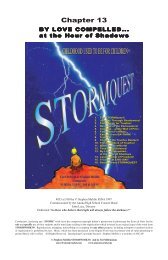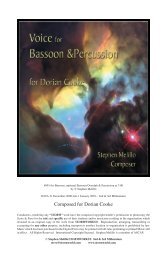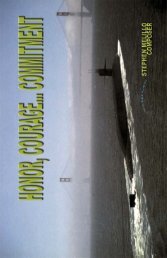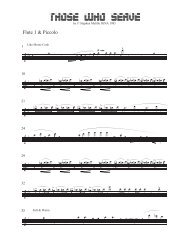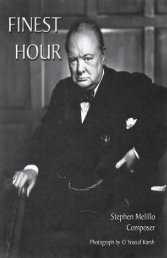Dr. David Wilborn Interview - STORMWORLD
Dr. David Wilborn Interview - STORMWORLD
Dr. David Wilborn Interview - STORMWORLD
You also want an ePaper? Increase the reach of your titles
YUMPU automatically turns print PDFs into web optimized ePapers that Google loves.
directors interpret a score?<br />
Steve: Wow. You realize of course that a substantive answer would deplete the Instrumentalist of pages!<br />
There is a preponderance of good texts, and of course college courses which respond to this. I would<br />
highly recommend Ed Lisk’s INTANGIBLES OF MUSICAL EXPRESSION. But let me focus on one<br />
specific aspect of score study which I think is lacking. I hope Instrumentalist will let me include a<br />
graphic! After an assimilation of the vocabulary and the orchestration, there is but one area that stands<br />
as the ultimate (ALL-TIME-ATE) union of conductor and composer, and that is in TIME. What flows<br />
IN Time is often not fully understood by the players or conductors. For instance, take the term DY-<br />
NAMIC. Ask a high school or college student what “dynamic” means. Though they’ve supposedly<br />
played them since 4th grade, they cannot adequately respond. I think that the readers should research the<br />
word in Webster’s Deluxe Unabridged Dictionary. Its relation to Music appears in the third definition...<br />
not the first or even the second. This is supremely important for educators to know. These “forces”, these<br />
levels of colour and texture and energy and interplay all carry out their living dance in the flow of Time.<br />
Not Tempo, mind you, but Time.<br />
Let me give a few examples. In my scores, you will see “real-Time” indications. These appear on the<br />
cover and within the body of the score at important, what I call “arrival points”. The more global tempo<br />
marking will put the conductor into the right arena, but with the ebb and flow of forces, it is the Time<br />
indication which gives the conductor a better sense of the WHEN.<br />
There is a moment in the Adagio of the 9th Symphony by Mahler, a single moment which I believe to be<br />
one of the most harrowing and completely powerful events in all of Music. This “moment” taken out of<br />
context means little. After all, it is merely sound. That “moment” is completely dependent upon ALL<br />
that has happened before it. We are led to that moment, nurtured, taught to love and feel that moment<br />
even before it arrives. Leonard Bernstein deeply understood this as he carefully recrafted the composition<br />
so that in real-Time, it would take on the dynamic as experienced and intended by the composer.<br />
I shuttle back and forth over that moment 100 times and feel the Music as it evolves to it, and then<br />
passes heart-wrenchingly, from it. Now, I ask you. What would have been the experience had we arrived<br />
there a minute too early? What if we arrived just seconds too early? What if we arrived 11 seconds too<br />
late? Would the meaning, the experience, the message of the composer survive and reach and uplift and<br />
inspire as it was meant to?<br />
It’s like leaning over and for the first time whispering, “I Love You”... before the candle-lit dinner,<br />
before you’ve arrived at the restaurant, before you’ve met for the date, before you’ve even shook hands!<br />
I enjoy it though, this period of discovery. It’s just a question of getting to know the composer, and that’s<br />
why I love to talk to so many fine educators over the phone or in person. This awareness of Time only<br />
makes sense in compositions that are charged with that sense of Integrity and purpose! And so, I must<br />
append my previous response to your question concerning choice of Music. Music must have a design, a<br />
plan... a reason.



